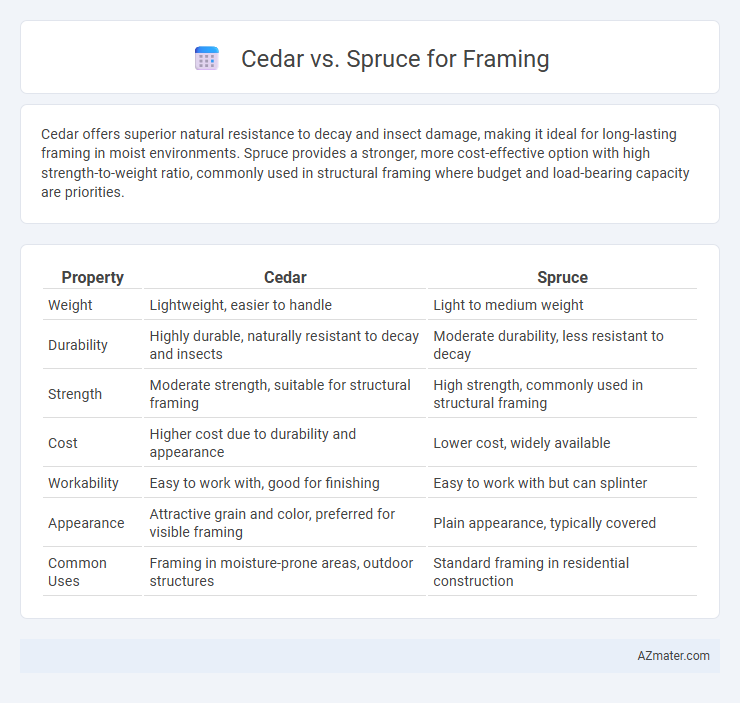Cedar offers superior natural resistance to decay and insect damage, making it ideal for long-lasting framing in moist environments. Spruce provides a stronger, more cost-effective option with high strength-to-weight ratio, commonly used in structural framing where budget and load-bearing capacity are priorities.
Table of Comparison
| Property | Cedar | Spruce |
|---|---|---|
| Weight | Lightweight, easier to handle | Light to medium weight |
| Durability | Highly durable, naturally resistant to decay and insects | Moderate durability, less resistant to decay |
| Strength | Moderate strength, suitable for structural framing | High strength, commonly used in structural framing |
| Cost | Higher cost due to durability and appearance | Lower cost, widely available |
| Workability | Easy to work with, good for finishing | Easy to work with but can splinter |
| Appearance | Attractive grain and color, preferred for visible framing | Plain appearance, typically covered |
| Common Uses | Framing in moisture-prone areas, outdoor structures | Standard framing in residential construction |
Introduction to Cedar and Spruce for Framing
Cedar is prized in framing for its natural resistance to decay, insect damage, and moisture, making it ideal for outdoor or humid environments. Spruce, commonly used in construction, offers a strong, lightweight option with good dimensional stability and is often more cost-effective than cedar. Both woods provide structural integrity for framing, but cedar's durability and aesthetic appeal make it a preferred choice for projects requiring longevity and natural resistance.
Wood Properties: Cedar vs. Spruce
Cedar wood features natural resistance to decay and insects, making it ideal for framing in environments prone to moisture and pests. Spruce, known for its straight grain and strength-to-weight ratio, offers excellent structural support with better dimensional stability under load. Both woods provide good workability, but cedar's lower density results in less weight, while spruce typically delivers higher stiffness, impacting frame durability and flexibility.
Strength and Durability Comparison
Spruce is widely favored for framing due to its high strength-to-weight ratio, providing excellent load-bearing capacity and structural integrity. Cedar, while offering superior resistance to rot and insects, lacks the same level of strength as spruce, making it less suitable for structural framing applications. The durability of cedar excels in moisture-prone environments, but spruce remains the preferred choice where framing requires maximum strength and stability.
Resistance to Decay and Insects
Cedar outperforms spruce in resistance to decay and insects due to its natural oils and tight grain structure, making it ideal for framing in humid or pest-prone areas. Spruce, while strong and affordable, lacks these natural protective properties, requiring chemical treatment to achieve similar durability. Choosing cedar for framing enhances longevity and reduces maintenance costs in environments prone to moisture and wood-boring insects.
Weight and Workability Differences
Cedar is lighter than spruce, making it easier to handle and transport on framing projects. Spruce, while heavier, offers greater stiffness and strength, which can enhance structural integrity in framing applications. The superior workability of cedar allows for smoother cuts and less tool wear, whereas spruce's density requires more effort but provides better resistance to splitting.
Moisture Resistance and Dimensional Stability
Cedar offers superior moisture resistance due to its natural oils and tight grain structure, reducing the risk of rot and decay in framing applications. Spruce, while less resistant to moisture, provides excellent dimensional stability, minimizing warping and twisting over time. For framing where exposure to moisture is a concern, cedar is preferred, whereas spruce is ideal for indoor framing requiring consistent shape retention.
Cost Analysis: Cedar vs. Spruce
Spruce framing lumber typically costs 20-30% less than cedar, making it a budget-friendly option for large-scale construction projects. Cedar's higher price reflects its natural resistance to decay, insects, and moisture, which can reduce long-term maintenance expenses. Evaluating total project costs requires balancing upfront material savings of spruce against cedar's durability and lifespan benefits.
Environmental Sustainability Considerations
Cedar offers superior environmental sustainability for framing due to its natural resistance to decay and insects, reducing the need for chemical treatments. Spruce, often sourced from fast-growing plantations, supports sustainable forestry practices but typically requires preservatives to enhance durability. Choosing locally sourced cedar or certified spruce from well-managed forests minimizes carbon footprint and promotes ecosystem health.
Best Applications for Cedar and Spruce
Cedar framing excels in applications requiring natural resistance to moisture, decay, and insect damage, making it ideal for outdoor structures like decks, pergolas, and siding. Spruce, valued for its high strength-to-weight ratio and affordability, is preferred in interior framing and load-bearing walls where structural integrity and cost-efficiency are critical. Both woods offer unique benefits: cedar's durability in harsh environments contrasts with spruce's versatility and strength in conventional construction projects.
Final Decision: Choosing the Right Framing Wood
Spruce offers a cost-effective, lightweight option with excellent strength-to-weight ratio ideal for framing, while cedar provides superior natural resistance to decay and insects, making it suitable for moisture-prone areas. The final decision depends on project budget, environmental exposure, and longevity requirements, with spruce favored for structural efficiency and cedar preferred for durability and aesthetics. Prioritize spruce for interior framing and cedar when durability against elements is critical to ensure optimal structural performance.

Infographic: Cedar vs Spruce for Framing
 azmater.com
azmater.com